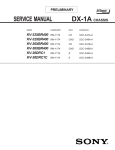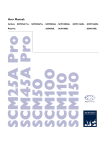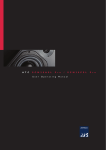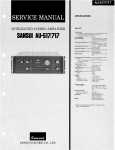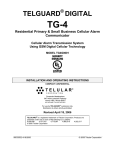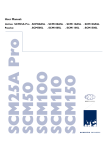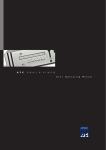Download User Manual: CA2 Preamplifier SCA2 Preamplifier P1 Power
Transcript
Amplifiers User Manual:CA2 Preamplifier SCA2 Preamplifier P1 Power Amplifier P2 Power Amplifier SIA2-150 Integrated Amplifier SPA2-150 Power Amplifier ® ACOUSTIC ENGINEERS Safety Warnings Electronics 1.Read instructions – all the safety and operating instructions should be read before the appliance is operated. 2.Retain these instructions – the safety and operating instructions should be retained for future reference. 3.Heed warnings – all warnings on the appliance and in the operating instructions should be adhered to. 4.Follow instructions – all operating and other instructions should be followed. 5.Water and moisture – the appliance should not be used near water, for example near a bathtub, washbowl, kitchen sink, laundry tub, in a wet basement or near a swimming pool etc.. 6.Ventilation – the appliance should be situated so that its location or position does not interfere with its proper ventilation. For example, the appliance should not be situated on a bed, sofa, rug or similar surface that may block the ventilation openings. Similarly, the appliance should not be built into an installation, such as a bookcase or cabinet, that may impede the flow of air through the ventilation Contents openings. 7.Heat – the appliance should be situated away from heat sources such Introduction Page 1 Page 1 Generic Information Section G1 Installation Section G2 Mains Connection Page 2 Section Section Section Section Page 3 CA2 Preamplifier Section 1.1 Description Section 1.2 Inputs Page 5 Section 1.3 Section 1.4 Section 1.5 11.Unattended periods – the power cord of the appliance should be Page 7 SCA2 Preamplifier Section 2.1 Description Section 2.2 Inputs unplugged from the outlet when left unused for a long period of Page 9 Section 2.3 Outputs time. Page 10 Section 2.4 Operation Page 11 Section 2.5 Specifications Page 12 P1 & P2 Power Amplifiers Section 3.1 Description Page 13 Section 3.2 Section 3.3 Section 3.4 Inputs Outputs Operation Page 14 Section 3.5 Specification Page 15 SIA2-150 Integrated Amplifier Section 4.1 Description Section 4.2 Inputs Section 4.3 Outputs Page 16 Section 4.4 Operation Page 17 Section 3.5 Specification Page 18 SPA2-150 Power Amplifier Section 5.1 Description Section 5.2 Inputs 15.Grounding or polarisation – precautions should be taken so that Page 19 Section 5.3 Section 5.4 Section 5.5 Signal Cable Options Outputs Operation grounding or polarisation means for the appliance are not defeated. Page 20 Section 5.6 Specifications as radiators, stoves or other appliances that produce heat. 8.Power sources – the appliance should be connected to a power supply only of the type described in the operating instructions or as marked on the appliance. 9.Power cord protection – power supply cords should be routed so that they are not likely to be walked on or pinched by items placed upon or against them, paying particular attention to cords at plugs, convenience receptacles and the point where they exit the appliance. 10. Cleaning – the appliance should be cleaned only as recommended by the manufacturer. 12.Object and liquid entry – care should be taken so that objects and liquids do not fall into the appliance. 13.Damage requiring service – the appliance should be serviced by qualified service personnel when: i. the power supply cord or the plug has been damaged ii. objects have fallen or liquid has been spilled into the appliance iii. the appliance has been exposed to rain or other serious liquid exposure iv. the appliance does not appear to operate normally or exhibits a marked change in performance v. the appliance has been dropped or the cabinet damaged 14.Servicing – the user should not attempt to service the appliance beyond those measures described in the operating instructions. All other servicing should be referred to qualified service personnel. G3 G4 G5 G6 Fuses ATC Remote Handset Care and Maintenance Warranty and Contact Outputs Operation Specifications Electronics Introduction Generic Information Welcome. In selecting ATC you have chosen an example of the finest The information in the following Sections audio engineering available. ATC was founded on a principle of G1 to G5 is common to all ATC electronics engineering excellence, and that principle still defines our products products. We recommend that you read today. Given the right opportunities, ATC products will deliver this page, and the safety exceptional audio performance, but the opportunities will only arise proceed it, before continuing to read the from careful and thoughtful installation and use. Please read the pages dedicated to your specific ATC following manual fully. It will help you understand the product and to products. warnings that realise its full potential. We are happy to answer questions and offer advice on any issues that arise through installation or use of ATC G1 Installation products. Contact details can be found at the back of this manual. ATC Equipment has been designed to be free ATC was founded in London in 1974 by Australian emigre Bill Woodman, who still standing either within an equipment stand or heads the company today. An enthusiastic pianist and engineer he was naturally simply on a convenient item of furniture. There are drawn to loudspeaker design and after a period working at Goodmans, where many of the names that went on to found British loudspeaker companies began their careers, he struck out on his own. The premise on which ATC began is a simple one, and one that in many respects is still true today: hi-fi loudspeakers tend to be detailed no special ventilation requirements (but please see notes on Amplifiers below). It is recommended that at least 100mm (4 inches) clearance be left behind a unit for plugs and cables. and accurate but of limited dynamic range, while professional monitor speakers tend ATC Equipment has been designed to remain to express the opposite character. ATC products were designed from the outset to powered-up in Standby mode unless it is to be offer the best of both. It’s an easy concept to describe, but surprisingly difficult to unused for a long period of time. Power dissipation engineer. will make the unit warm to the touch in either The difficulty inherent in designing such loudspeakers is one of scale. Hi-fi levels of accuracy and detail call for lightweight moving parts and delicate engineering. Professional monitor levels of performance however demand far more robust components engineered to survive the rigours of high level use for extended periods. The only way to combine the two is through precision engineering of a class and scale more often associated with aerospace or motor-sport. But the results are worth the effort and the cost. ATC loudspeakers, with their unique in-house designed drivers, combine the best of hi-fi and professional to devastating effect. standby or operational mode. Temperature stability will be reached after approximately three hours from mains switch-on. Full Audio performance is available immediately. ATC Preamplifiers should be located as close to the source components as practically possible to minimise the cable length. The Outputs however are capable of driving up to 50 metres of good quality cable; therefore it is practical to locate the ATC has become synonymous with active systems. Choosing to offer active Preamplifier a distance away from the monitor or loudspeakers (where the passive crossover network is replaced by active filters and Power Amplifier (s). multiple power amplifiers) is simply a result of the uncompromising attitude to loudspeaker design. While passive systems still have their place, and ATC engineering skills can still bring remarkable results from them, “active” is a fundamentally better solution to the problems posed by accurate, high level music reproduction. The ATC instinct is always for the better solution. Not cheaper, not quicker, but better. ATC Power Amplifiers should ideally be located to minimise the cable lengths from both the source components and the Loudspeakers. Use of loudspeaker cables in excess of 20 metres should be avoided if possible to prevent a possible It was the development of active loudspeakers that first brought ATC into electronics degradation in sound quality. Care must be taken to design and engineering. Active speakers demand multiple power amplifiers so ATC ensure that ventilation holes in the top and bottom from the mid 1980s became not just a loudspeaker manufacturing company but an electronics manufacturer too. The further step from electronics for active speakers to a range of stand-alone amplifier products was natural and now means that ATC covers are not obscured. Please contact ATC if the Amplifier is to be mounted in an enclosed area. engineering is available from the recording desk or CD player output to the ears. G2 Mains Connection From modest beginnings ATC has grown to become one of the very few The CA2 and SCA2 Preamplifiers can be used with manufacturers successful across both domestic and professional audio. By selecting ATC you join a group of music lovers, professional audio engineers, studios and musicians across the World that understand and value the engineering that goes into an ATC product - and the sound that comes out. mains voltages from 100V to 240V, 50/60Hz. Please ensure that the local mains voltage matches that uppermost on the rear panel voltage selector plate before applying mains power to the unit. The mains voltage selection can be adjusted by lifting the selector plate marked with four legends (100, 120, 1 Electronics 220, 230) with a small screwdriver and re-inserting standard set of CD Player commands, which may be used to control any CD or the plate with the correct voltage uppermost. DVD/SACD Player that supports the standard RC5 control code set. The SIA2-150 and SPA2-150 Power Amplifiers can Use the handset On/Reset button to switch the SCA2 into active mode and the be used with mains voltages from 100V to 240V, Standby button to return the SCA2 to Standby mode. Monitor and Record selection 50/60Hz. can be made by pressing the desired monitor or record button. The SCA2 front The P1 Power Amplifier can be used with mains voltages from 100V to 240V, 50/60Hz Mains voltage is factory set and should only be adjusted by ATC or your local dealer or distributor. Please ensure that the local mains voltage matches panel source indicators will illuminate but the rotary controls will not rotate. Volume is controlled through the handset Level + and – buttons. The SCA2 front panel Level control will rotate in response to handset level commands. The handset Attn button is equivalent to the front panel Gain function.The handset Mute function operates in exactly the same way as the front panel control. that specified on the rear panel before applying The red indicator on the handset will flash as functions are operated. Failure of this power to the SIA2-150, SPA2-150 or P1 indicator points to exhaustion of the handset battery.The battery should be replaced, Amplifiers. and the old battery disposed of, by your local dealer or distributor. The mains cable has been specifically supplied to The CA2, SIA2-150 and P1 are supplied with the SCAR-B remote handset. This comply with local statutory safety approvals and provides for remote operation of all functions of the units, and includes a standard alternatives should not be substituted. If you Intend set of CD Player commands that may be used to control any CD or DVD/SACD to use your unit in an alternative territory, please player that supports the RC5 control set. Power is supplied by 4 X AAA batteries contact ATC for advise. (included). ATC equipment MUST be earthed. Do not remove ATC remote handsets may be used with the SPA2-150 to provide remote operation the earth wire in the mains plug. of the standby function. G3 Fuses Reliable operation of the remote handsets require direct line of sight between the handset and the unit front panel. Correct operation of the handset on the SCA2 is Mains power supply fuses are fitted within the CA2 indicated by illumination of a red indicator on the left hand side of the front panel as and SCA2, but they are not intended to be user handset commands are received. replaceable. The mains power supply fuse for the SIA2-150, G 5 C a re a n d M a i n t e n a n c e SPA2-150 and P1 Amplifiers is located on the rear ATC use high technology material finishes in all of their products. The surfaces are panel. Should the Amplifier fail to switch on when durable and with a little care can be kept as good as new even under conditions of the power switch is operated, the fuse should be heavy use. Normally a dry duster is all that is required to keep the finishes clean. inspected. PLEASE ENSURE THAT THE UNIT IS Heavy soiling can be cleaned using a slightly moistened cloth with a non-abrasive DISCONNECTED FROM THE MAINS SUPPLY household cleaner. BEFORE INSPECTING OR REPLACING A FUSE. Lift out the fuse holder cover using a small screwdriver, remove the fuse and inspect it for damage. Fuses most often fail due to a serious electrical fault. Only replace fuses with the same type as that suspected to be blown. All fuses are 20mm “Type T anti surge”.The fuse rating is printed G6 Wa rra nty a nd Contact All ATC products are guaranteed against any defect in materials or workmanship for a period of two years from the date of purchase. Within this period we will supply replacement parts free of charge provided that the failure was not caused by misuse, accident or negligence. on the rear panel adjacent to the fuse. If a Purchasers who complete and return the Warranty Card will have their warranty replacement fuse also fails then the Amplifier period extended up to a period of six years from the date of purchase. This should be returned to ATC for service. guarantee does not limit your statutory rights. ATC can be contacted at: Loudspeaker Technology Ltd. G 4 ATC R e m o t e H a n d s e t s The SCA2 is supplied with an SCA R remote handset. Provided that the SCA2 is connected to the mains power and its rear panel power switch is on, the SCA R provides for remote operation of all the SCA2 functions. The SCA R also includes a 2 Gypsy Lane, Aston Down, Stroud, Gloucestershire. GL6 8HR UK Telephone: 01285 760561 Fax: 01285 760683 Email: [email protected] WWW: www.atc.gb.net CA2 Preamplifier 1 . 1 D e s c ri p t i o n The CA2 preamplifier has been designed to partner ATC active, and with an appropriate power amplifier, passive loudspeaker systems. It incorporates 4 line-level stereo inputs, a high sensitivity phono amplifier input, and a tape monitor input on RCA phono sockets. One stereo record output, a main stereo output and a sub output on RCA phono sockets, together with a main stereo output on XLR sockets and a headphone output on a ¼ ” jack socket. The phono amplifier stage carries an array of slide switches that enable optimal matching to phono cartridges of various output voltages and load requirements. Selection of CA2 inputs is achieved via a five position rotary control using gold plated relays for silent switching. Output volume adjustment is achieved through a precision motorized potentiometer. The tape monitor function can be selected from a front panel push button. The tape output is a duplicate of the source selected by the input selector. Standby is also accessible from a front panel push button. Mains power is applied from a rear panel mounted switch. All CA2 functions are duplicated on the ATC SCAR-B remote handset. 1.2 Inputs The CA2 accepts unbalanced RCA phono style input plugs. The signal is present on the centre conductor of an unbalanced input and the signal return is made via the screened outer. If there is any hum present on the output this must be traced to its source and not suppressed by the removal of screens and earths. Removal of the screen on an unbalanced input will result in uncontrollably loud hum. The input sockets are illustrated in Diagram 1. Inputs labeled CD, TUNER, AV and AUX1 are at line sensitivity and are electrically identical. A line level signal from any source equipment may be connected to any of these inputs. The right-hand (viewed from the rear) pair of AUX2/PHONO input sockets function as a high sensitivity phono input. All inputs are via RCA phono connectors. Diagram 1 - CA2 rear panel and connection sockets 3 CA2 Preamplifier The phono amplifier can be configured to accommodate a wide selection of phono cartridge types by setting combinations of the board mounted jumpers (links). Access to the phono stage is gained by removing the cover of the preamplifier. Diagram 2 illustrates the position of the jumpers on the board while Table A details the cartridge matching options available. Pulling them gently away from the board with a small pair of pliers and replaced in the appropriate positions as shown in the diagram moves links. Unused links can be “parked” on the board by setting them at right angles on unused pins. Jumpers J2 and J5 set the input load for each channel of the cartridge. With the jumper in place the load is 100 ohms. With the jumpers removed the load is 47kilohms. Jumpers J3, J6, J1 and J4 set the gain (sensitivity) of the phono input. J3 and J6 have two positions A and B. In position A the gain of the phono stage is reduced, in position B the gain is increased. J1 and J4 can have the jumper fitted or removed. When fitted the gain of the circuit is increased. By setting combinations of these 4 jumpers, a range of sensitivities can be accommodated. or example: for a cartridge with a low sensitivity J3 and J6 would be set in position B while J1 and J4 Diagram 2 - RIAA Phono Board and Jumpers would both have their jumper fitted. Table A illustrates the input sensitivity and load characteristics available. The manufacturer of the cartridge in use will be able to recommend the appropriate settings. J1 J2 J3 Pos A Pos B J4 J5 J6 Pos A Pos B Table A - RIAA Jumper Settings Jumper settings for 1 Volt Output Sensitivity 4 10.0mV 6.7mV 5.1mV 3.4mV 2.2mV 1.4mV 1.1mV 0.7mV J1 and J4 J2 and J5 Removed Removed Removed Removed Fitted Fitted Fitted Fitted Fitted (100Ω ) Removed (47kΩ Fitted (100Ω ) Removed (47kΩ Fitted (100 ) Removed (47kΩ Fitted (100Ω ) Removed (47kΩ J3 and J6 ) ) ) ) Position A Position A Position B Position B Position A Position A Position B Position B CA2 Preamplifier 1.3 Outputs Diagram 3 - output socket pins The CA2 rear panel illustrated in Diagram 1 carries sockets for main left and right output, tape left and right output, left and right summed mono output and an output for stereo Pin 1, ground headphones. Use of the headphone jack will mute the output Pin 2, Signal (hot) Pin 3, Signal (return) from the main stereo output and also the sub output. Connections to the main output may be from RCA phono plugs or XLR plugs. Connections to the XLR output sockets follow the convention of pin 1 to ground, pin 2 to signal “hot” Diagram 4 - balanced cable and pin 3 to signal return (signal ground). When connecting to equipment with XLR (balanced) inputs, the connectors should be wired pin for pin (i.e. 1 to 1, 2 to 2, and 3 to 3). Diagram 3 illustrates the XLR output pin arrangement. Diagram 4 illustrates the cable arrangement for connection to balanced inputs. Cables up to 50 metres in length may be connected to the main stereo or sub outputs. 3 Pin Male XLR Connector 3 Pin Female XLR Connector Two Core Screened Cable 2 Hot Return 2 1 Screen 1 3 To Preamp Output 3 To Power Amp or Monitor Input 1.4 Operation Once connected to mains power and powered up from the rear panel mains switch, the front panel Standby button (or remote handset Standby button) will switch the CA2 between standby and active mode. In Standby mode the Standby Indicator glows RED. Operating the Standby function from either the front panel or the remote handset will switch the CA2 into active mode. The RED indicator will extinguish and be replaced by the Input select indicator showing the current selection in GREEN. Operating the Standby function again will return the CA2 to Standby mode. Inputs are selected by rotating the input select control in either direction. The control has continuous movement. When it is moved to the last input, further rotation will select the first input. A separate tape loop is included with a Monitor option selected by a single push button on the front panel. The tape output will have the same signal as selected by the rotary input select control. Operation of the Standby or tape monitor controls will not affect this output providing mains power is maintained. Diagram 6 - CA2 front panel and controls 5 CA2 Output level is controlled by the rotary Volume control on the front of the unit, the position of which is indicated by a black pointer. Rotating the Preamplifier 1.5 Specifications Maximum Output Level 7.5V RMS into 600 Ohms Line Input Sensitivity (for 1V Output): 150mV R.I.A.A. Input sensitivity: See Table A R.I.A.A. Input Impedance: See Table A R.I.A.A. Accuracy (20Hz – 20kHz): ±0.5dB Unity gain though the CA2 from any of the line Input Impedance: 5k Ohms level inputs is indicated by the ‘0dB’ print on the Output Impedance: 10 Ohms front panel, beside the volume control. This is the Frequency Response (-3dB): DC – >500kHz volume position the preamp should be set to for Total Harmonic Distortion: <0.0005% (-106dB) 1V into 600 Ohms ‘Home Cinema Bypass’ so the CA2 has no Crosstalk (10Hz – 20kHz) >90dB influence on signal level when used within a cinema S+N/N Ratio: >95dB (Wide band) >104dB (DIN) >108dB (IEC "A") Due to the nature of the electronics in ATC Power Requirements 100, 115, 230V, 50/60Hz amplifiers it is quite normal for a sound to be heard Power Consumption 35VA Maximum from the speaker when the power is applied or Dimensions (including terminals) H90 x W445 x D330mm H3.54 x W17.5 x D13.0 inches Weight 7kg (15.4lb) Net 8kg (17.6lb) Packed control clockwise will increase the output level. It is good practice to lower the volume setting before switching on the preamplifier or any associated equipment, or while changing the input selection. surround system. disconnected. The noise heard will not damage the speaker and is quite normal. Although ATC uses the highest-grade components, a different noise may be heard from each speaker due to slight tolerance variations in the amplifier components. E. & O.E. The policy of Loudspeaker Technology Ltd. is that of continuous design and development. We reserve the right to change specifications without prior notice. 6 Preamplifier SCA2 2 . 1 D e s c ri p t i o n The SCA2 is an extremely high resolution preamplifier designed to partner ATC active, and, with an appropriate power amplifier, passive loudspeaker systems. It incorporates eight line-level stereo inputs, two stereo signal outputs and two stereo record outputs. Two of the line inputs are balanced format on XLR sockets while the remaining inputs are unbalanced and on pairs of RCA phono sockets. The main stereo output is balanced format on a pair of XLR sockets while the auxiliary stereo output is unbalanced and on a pair of RCA phono sockets. The two record outputs are unbalanced on pairs of RCA phono sockets. The AUX 2 line-level input may be converted to function as a high-sensitivity phono input through the addition of a factory fitted optional RIAA Phono Board. The RIAA board carries an array of slide switches that enable optimal matching with phono cartridges of various output voltages and loading requirements. Selection of SCA2 inputs is achieved via a eight-position rotary control using gold plated relays for silent switching. The SCA2 incorporates an independent record output signal path so enabling simultaneous listening and recording of different source signals. Selection of the record output signal is achieved via a second eight-position rotary control using gold plated relays for silent switching. 2.2 Inputs Output volume adjustment is achieved through a precision motorised potentiometer. The SCA2 can accept two balanced XLR inputs Mute, gain and standby functions are also accessible from font panel push buttons. and six unbalanced RCA phono style inputs (2 as Mains power is applied from a rear panel mounted switch. part of tape record/listen sets). The rear panel and All SCA2 functions are duplicated on the ATC SCA-Remote control handset. input sockets are illustrated in Diagram 1.The input types and their identifying legends are illustrated in following Table A. The AUX 2 input sockets will function as a highsensitivity phono input if the optional SPH2 RIAA Vinyl Board is installed. The RIAA circuitry can be configured to accommodate a wide selection of phono cartridge types by setting combinations of board mounted links. Access to the board is gained by removing the top panel of the preamplifier. Diagram 2 illustrates the position of the links on the board while Diagram 3 and Table B detail the cartridge gain and input matching options available. Links are moved by pulling them gently away from the board with a small pair of pliers and are replaced in the appropriate positions as shown in the diagrams. Unused links can be “parked” on the board by setting them at right angles on unused pins. The SPH2 board is split into two identical channels. For the sake of clarity on the diagrams, the settings for only one channel are shown. Settings for one channel should be duplicated on the other. The cartridge gain and matching options should be used as described below. 7 SCA2 Preamplifier Diagram 1 - SCA2 rear panel and connection sockets Table A - Input Sockets Input socket types and legends Rear Panel Legend Front Panel Input Legend Type Notes balanced input cd cd bal XLR balanced x 2 balanced input aux 1 aux 1 XLR balanced x 2 input aux 2 aux 2 RCA phono x 2 Marked “phono” on rear if SPH2 RIAA board fitted input tuner tuner RCA phono x 2 input tv/av a/v RCA phono x 2 input cd cd RCA phono x 2 input tape 2 tape 2 RCA phono x 2 Part of record/listen set input tape 1 tape 1 RCA phono x 2 Part of record/listen set Diagram 2 - SPH2 Board and Link Locations Capacitor bank. See Diagram 3 Resistor bank. See Diagram 3 Z1 Z2 Z3 X-X Y- Y Diagram 3 - SPH2 Load Capacitor and Resistor Options Link across for 2200pF Link across for 1000pF Link across for 470pF Link across for 220pF Link across for 100pF Link Link Link Link Link Link Link across across across across across across across for for for for for for for Trim -50 ohms 8 400 ohms 500 ohms 300 ohms 600 ohms 200 ohms 700 ohms 100 ohms SCA2 Preamplifier amplifier (or active speakers). Use the balanced Table B - RIAA Board Gain Stage Link Setting Mid point gain stage set LOW (11dB) Z2 option in preference if both options are possible. Link Z1 to Connections to the primary output XLR sockets follow the convention of pin 1 to ground, pin 2 to First gain stage settings. signal “hot” and pin 3 to signal return (signal Gain Setting Gain mV Gain dB Link Position High High/mid Mid Low 1.14mV 1.6mV 3.3mV 33.0mV 59dB 55dB 49dB 30dB Link both Y-Y and X-X Link Y-Y only Link X-X only No links Mid point gain stage set HIGH (24dB) Z3 ground). When connecting to equipment with XLR (balanced) inputs the connectors should be wired pin for pin (ie. 1 to 1, 2 to 2 and 3 to 3). Diagram 4 illustrates the XLR output pin arrangement and Diagram 5 the connection scheme for a balanced Link Z2 to XLR - XLR cable. The unbalanced main left and right outputs and the First gain stage settings. tape record outputs should be connected using Gain Setting Gain mV Gain dB Link Position High High/mid Mid Low 0.25mV 0.38mV 0.78mV 7.5mV 71dB 68dB 62dB 42dB Link both Y-Y and X-X Link Y-Y only Link X-X only No links good quality RCA phono terminated leads. Use of the front panel volume, mute, or gain functions does not effect the tape record signal. Cables up to 50 metres in length may be connected Gain: Gain is set by fitting the Z link in one of two positions (Z1 to Z2 or Z2 to Z3) to the main outputs. Tape record cables should be and by setting a combination of X and Y links. These links should be fitted according limited to 10 metres. to the desired input sensitivities specified in Table B. Capacitive Load: Capacitive load is set by selecting a link for the appropriate capacitance value as illustrated in Diagram 3. Multiple links may be be used, in which case the load value is the sum of the selected values. For example, links in the 470pF position and 1000pF position give a total load value of 1470pF. Resistive Load: Resistive load is set by selecting a link for the appropriate capacitance value as illustrated in Diagram 3. If no link is selected the default resistive load is 47 kilohms - appropriate for the majority of moving-magnet cartridges. A link in the -50 position will reduce any selected load by 50 ohms. For example, links in the 200 position and -50 position give a total load value of 150 . Diagram 4 - balanced output socket pins Cartridge suppliers and manufacturers will be able to provide details of the loading and gain settings appropriate to their products. On some occasions there will be no specific Pin 1, ground recommendation for the capacitive load on moving-coil Pin 2, Signal (hot) Pin 3, Signal (return) cartridges. In these cases it is best to assume no capacitance need be selected (no links used). The rear panel ground terminal should be used to connect the pick-up arm earth lead. Diagram 5 - balanced cable pin connections 2.3 Outputs The SCA2 rear panel, illustrated in Diagram 1, carries sockets for balanced main left and right output, unbalanced 3 Pin Male XLR Connector main main left and right output, and two unbalanced tape record outputs. Choice between the balanced and unbalanced main outputs will depend on the input capabilities of the following power 3 Pin Female XLR Connector Two Core Screened Cable 2 Hot Return 2 1 Screen 1 3 To Preamp Output 3 To Power Amp or Monitor Input 9 SCA2 Preamplifier Diagram 6 - SCA2 front panel and controls 2.4 Operation Optimum sound quality will be achieved when the SCA2 has reached normal Once connected to mains power and powered-up operating temperature and for this reason it is recommended that it be left in from the rear panel mains switch, the front panel standby mode when not in use. It is a wise precaution however to switch-off the Standby Reset button (or remote handset Standby SCA2 from the rear panel power switch if it is to be left unused for an extended button) will switch the SCA2 between standby and period. active modes. In standby mode the Standby Reset The Record select control selects the input source routed to the tape outputs. The indicator will illuminate. Operating the Standby green indicator next to each record option will illuminate to indicate selection. The Reset function will switch the SCA2 into active control has continuous movement. When it is moved to the last input, further mute mode. The Standby Reset indicator will rotation will select the first input. The source selected is made available at the tape extinguish and the Mute indicator will illuminate. output sockets and is fully buffered to prevent signal interaction. The Level, Gain and The Mute function automatically engages when the Mute functions have no effect on the record output signals. SCA2 is switched from standby to active mode. This precautionary feature provides an opportunity for the volume and input settings to be checked before audio is passed to the power amplifiers. If all is well, the SCA2 may be brought into full operation by pressing the Mute function. The Mute indicator will extinguish. The Mute function can be used at any time to silence the system. Inputs are selected by rotating the Monitor select control. The green indicator next to each monitor option will illuminate to indicate selection. The control has continuous movement. When it is moved to the last input, further rotation will select the first input. Volume level is adjusted by rotating the Level control. A red indicator on the control indicates the level selected. Volume level can be reduced immediately by 12dB by operating the Gain function. The Gain indicator illuminates to indicate its use. 10 Tape copying can be performed by selecting Tape 1 on the Record control to copy from Tape 1 to Tape 2. In this case no signal will be routed to the Tape 1 output sockets. Copying from Tape 2 to Tape 1 can be achieved in a similar manner. Selecting Tape 1 on the Monitor control while also recording to Tape 1 (i.e. tape 1 is also selected on the record control) enables the off-tape signal from a three head tape machine to be monitored. The Tape 2 circuit works in an identical manner. Due to the nature of the electronics in ATC amplifiers it is quite normal for a sound to be heard from the speaker when the power is applied or disconnected. The noise heard will not damage the speaker and is quite normal. Although ATC uses the highest-grade components, a different noise may be heard from each speaker due to slight tolerance variations in the amplifier components. SCA2 Preamplifier 2.5 Specifications MAIN OUTPUTS Maximum Output Level 8.5V RMS into 600 Ohms balanced 17.5V RMS into 600 Ohms unbalanced Input Sensitivity (for 1V Output) 230mV Input Impedance Phono (Unbalanced) 20k Ohms XLR (Balanced) 2k7 Ohms per leg Output Impedance 10 Ohms Frequency Response (-3dB) DC - 500kHz Total Harmonic Distortion 0.0005% (-106dB) @ 1V into 600 Ohms Crosstalk (10Hz – 20kHz) >90dB S+N/N Ratio: >95dB (Wide band) >104dB (DIN) >108dB (IEC "A") Residual noise >116dB (IEC "A") Absolute phase Phono (Unbalanced) Zero Degress XLR (Balanced) Zero Degrees, Pin 2 Hot XLR CMRR (100Hz – 10kHz) >90dB Power Requirements 100V, 120, 220, 230V 50/60Hz Power Consumption 35VA maximum Dimensions (including terminals) H100 x W440 x D360mm H3.9 x W17.3 x D14.2 inches Weight 9.5kg (20.9lb) Net 11.0kg (24.2lb) Packed E. & O.E. The policy of Loudspeaker Technology Ltd. is that of continuous design and development. We reserve the right to change specifications without prior notice. 11 P1 & P2 3 . 1 D e s c ri p t i o n The ‘P’ Series stereo power amps are a range of high quality power amplifiers designed to partner ATC passive monitors and other loudspeaker Power Amplifiers achieve the maximum signal separation and minimum crosstalk. Further, Intermodulation between channels via the power supplies is reduced to an absolute minimum at all frequencies, and, the power delivery from one channel cannot affect the specified power available from the other channel. systems. The range consists of P1, P1 Pro, P2 and The amplifier mains power is turned on by a push button on the rear panel. There is P2 Pro. The ‘Pro’ versions differ by featuring 19” a Green L.E.D. on the front panel to indicate that the mains supply is connected, rack mount chassis, front panel mounted standby together with a Red L.E.D. to indicate that the Amplifier is in Standby. The Amplifier button and remote standby trigger via a rear panel can be brought out of Standby by the Standby button on the ATC SCA-R remote mounted connector. The amplifiers incorporate control (supplied with P1 and P2). On the rear panel is a push button to defeat the same gain reduction and loudspeaker protection remote control operation in which case, when the Amplifier is switched on the unit circuits as used in the ATC active monitors. This will not be in Standby, The Red L.E.D. will be off, and the Remote control has no ensures that even working at very high levels the effect. amplifier is held back from clipping so improving the subjective performance and protecting the loudspeakers from damage. All the amplifiers in the series are of a "true" Dual The P1 Pro and P2 Pro amplifiers can be bought out of standby using the front panel mounted button. No IR remote is supplied with the ‘Pro’ versions of the amplifiers and they do not feature IR defeat on the rear panel. They do feature remote triggering of standby via a rear panel mounted 5 – 12v ac/dc input. Mono design, in that the power supplies signal and return paths are totally separated from each other. This approach ensures that the Amplifier will Diagram 1 - PI rear panel and connection sockets Diagram 2 - PI Pro rear panel and connection sockets 12 P1 & P2 Power Amplifiers 3.2 Inputs 3.3 Outputs Single ended Inputs via RCA phono sockets, and Differential (balanced) Inputs via XLR sockets are provided. Each channel has two phono Input sockets, the ”Link” Input phono sockets may be used to connect the Amplifier Inputs to a further ATC Power Amplifier for Instance as a Sub Channel. Loudspeaker connections are made using the two pairs of proprietary ATC loudspeaker terminals. The left and right channels are clearly marked and correspond to the left and right inputs.The positive terminal is marked red and the negative terminal is marked black. Diagram 3 - P2 rear panel and connection sockets Diagram 4 - P2 Pro rear panel and connection sockets 3.4 Operation The amplifier can be brought out of Standby by pressing the Standby push button on the remote P1 (Hi-Fi Model) control. A further press of the button will put the amplifier back into standby. A push button on the rear panel marked “ir disable” defines how the P1 will operate once connected to mains power and powered-up from the rear panel mains push P2 (Hi-Fi Model) button. If the push button is “in”, the amplifier will power- up in “active” mode indicated by a GREEN light on the front panel, the remote control will be inoperative. Operation is identical to that of the P1 except that the P2 also features fault monitoring of clip events, overload and output stage dc offset. The events are If the push button is “out”, the unit will power-up in Standby indicated by a RED light displayed via additional LEDs mounted in the front on the front panel. panel central indicator labeled ‘clip’ and ‘error left’ 13 P1 & P2 Power Amplifiers and ‘error right’. Clip events are displayed by a P1 Pro and P2 Pro momentary blinking of the clip LED. If a number for clip events occur in a short space of time Operation of these two variants is exactly the same as the P2 (Hi-Fi) except for the (overload) then the amplifier will shut down into added features of a front panel mounted standby button and a rear panel mounted ‘protect’ mode and one of the front panel ‘error’ remote standby trigger input. The remote trigger input is via a lockable 5.5mm jack LEDs will be lit. The amplifiers standby function plug and accepts 5 – 12 V ac/dc. Standby can also be triggered via IR remote although will need to be cycled to restore normal operation. a handset is not supplied. However, the amp is likely to switch quickly back to Due to the nature of the electronics in ATC amplifiers it is quite normal for a sound ‘protect’ mode unless the output level has been to be heard from the speaker when the power is applied or disconnected. The noise reduced prior to reset. heard will not damage the speaker and is quite normal. Although ATC uses the These features are to ensure the longevity of the amplifier and protect highest-grade components, a different noise may be heard from each speaker due to slight tolerance variations in the amplifier components. loudspeakers from potential damage! Please take note! 3.5 Specifications P1 Power Output (1% Distortion, 1kHz, Both channels driven, Continuous average) P1 Pro P2 >150W into 8 Ohms >200W into 4 Ohms Frequency Response P2 Pro >250W into 8 Ohms >370W into 3 Ohms <2Hz – >400kHz (-3dB) Distortion <0.003% (-95dB) (1kHz, 8 Ohms, 1dB below full power) Input Sensitivity 2.0V/3dBV/4.1dBu (150 Watts, 8 Ohms, 1kHz) Input Impedance 10k Ohms (Phono) 10k Ohms/Leg (XLR) >100dB (Wideband) >110dB (DIN) >115dB (IEC "A") Crosstalk >100dB S+N/N Ratio (10Hz – 20kHz) Damping Factor >400 (8 Ohms) Absolute Phase Zero Degrees (Phono) Zero Degrees (XLR, Pin 2 Hot) XLR Common Mode Ratio >60dB (100Hz – 10kHz) Power Requirements100, 115, 230V factory set, 50/60Hz Power Consumption 2VA Standby 600VA Maximum Remote Standby Trigger Input None 5 – 12v ac/dc None 5 – 12v ac/dc Dimensions (H x W x D) 135 x 435 x 350mm 5.32 x 17.13 x 13.78 in 135 x 483 x 350mm 5.32 x 19.0 x 13.78 in 135 x 435 x 350mm 5.32 x 17.13 x 13.78 in 135 x 483 x 350mm 5.32 x 19.0 x 13.78 in Weight 23kg/50.6lbs Net 25kg/55lbs Packed 23.5kg/51.7lbs Net 25.5kg/56.1lbs 25kg/55lbs Net 27kg/59.4lbs 25.5kg/56.1lbs Net 27.5kg/60.5lbs E. & O.E. The policy of Loudspeaker Technology Ltd. is that of continuous design and development. We reserve the right to change specifications without prior notice. 14 3VA Standby 1000VA Maximum SIA2-150 Integrated Amplifier 4 . 1 D e s c ri p t i o n 4.3 Outputs The SIA2-150 is a high quality integrated amplifier designed to partner ATC passive The SIA2-150 rear panel, illustrated in diagram 1, monitors and other Loudspeaker systems. It incorporates five line level stereo inputs carries connectors for left and right loudspeakers, plus headphone jack, stereo record, pre and sub outputs on RCA phono sockets and Tape left and right outputs, Preamplifier left and one pair of loudspeaker outputs. right outputs and a left and right summed mono Input selection is achieved via a rotary control. Output volume adjustment is achieved output. by a precision potentiometer. A tape monitor function is a duplicate of the source Loudspeaker connections are made using the two selected by the input selector. A standby function is also accessible from a front panel pairs of proprietary ATC loudspeaker terminals. push button. Mains power is applied from a rear panel mounted switch. The positive terminal is coloured red and the The SIA2-150 incorporates the same gain reduction and loudspeaker protection circuits as used in the ATC active monitors.This ensures that even working at very high levels the amplifier is held back from clipping so improving the subjective performance and protecting the loudspeakers from damage. negative terminal is coloured black. The left and right channels are clearly marked and correspond to the left and right inputs. The wire used for the connections to the monitors will have some identification for the positive conductor. Usually All SIA2-150 functions are duplicated on the included ATC SCAR-B remote control this is red, but may be a moulded stripe on the handset. insulation. 4.2 Inputs The SIA2-150 accepts unbalanced RCA phono input plugs. The signal is present on the centre conductor of an unbalanced input and the signal return is made via the screened outer. If there is any hum present on the inputs, this must be traced to its source and not suppressed by the removal of screens or earths. Removal of the screen on an unbalanced input is likely to result in uncontrollably loud hum.The input sockets are illustrated in diagram 1. All inputs are line level sensitivity via RCA phono connectors on the rear panel. Inputs are labeled CD, Tuner, AV, Aux., and Tape. in. However, they are electrically identical and a line level signal from any source equipment may be connected to any input. Diagram 1 - SIA2-150 rear panel and connectors 15 SIA2-150 Integrated Amplifier Diagram 2 - SIA2-150 front panel and controls 4.4 Operation Once connected to mains power and powered up from the rear panel mains switch, the front panel headphones. When headphones are connected the signal to the speakers, sub and pre out is muted. Standby button (or remote handset Standby button) Output level is controlled by the rotary Volume control on the front of the unit, the will switch the CA2 between standby and active position of which is indicated by a black pointer. Rotating the control clockwise will mode. In Standby mode the Standby Indicator glows increase the output level. It is good practice to lower the volume setting before RED. Operating the Standby function from either switching on the preamplifier or any associated equipment, or while changing the input the front panel or the remote handset will switch selection. the CA2 into active mode. The RED indicator will extinguish and be replaced by the Input select indicator showing the current selection in GREEN. Operating the Standby function again will return the CA2 to Standby mode. Inputs are selected by rotating the input select control in either direction. The control has continuous movement. When it is moved to the last input, further rotation will select the first input. A separate tape loop is included with a Monitor option selected by a single push button on the front panel. The tape output will have the same signal as selected by the rotary input select control. Operation of the Standby or tape monitor controls will not affect this output providing mains power is maintained. A pair of phono sockets on the rear panel can be used to drive another amplifier. A further pair of phono sockets can be used to drive a Sub channel Amplifier. 16 A Headphone output is provided via a ¼” Jack socket to drive a variety of popular Due to the nature of the electronics in ATC amplifiers it is quite normal for a sound to be heard from the speaker when the power is applied or disconnected. The noise heard will not damage the speaker and is quite normal. Although ATC uses the highestgrade components, a different noise may be heard from each speaker due to slight tolerance variations in the amplifier components. Specifications SIA2-150 4.5 Specifications Power Output >150 Watts (1% Distortion, 1kHz, Both channels driven, Continuous average) Frequency Response (-3dB) <2Hz – >400kHz Distortion <0.002% (-95dB) (1kHz, 8 Ohms, 1dB below full power) Input Sensitivity 350mV (150 Watts, 8 Ohms, 1kHz) Input Impedance 20k Ohms S+N/N Ratio >100dB (Wideband) Crosstalk >90dB (10Hz – 20kHz) Absolute Phase Zero Degrees (Phono) Power Requirements100, 115, 230V factory set, 50/60Hz Power Consumption 10VA Standby 500VA Maximum Dimensions (H x W x D) (Including terminals) ??? x ??? x ???mm ??? x ??? x ??? inches Weight ??kg/??lbs Net ??kg/??lbs Packed E. & O.E. The policy of Loudspeaker Technology Ltd. is that of continuous design and development. We reserve the right to change specifications without prior notice. 17 SPA2-150 Power Amplifier 5 . 1 D e s c ri p t i o n 5.2 Inputs The SPA2-150 is a high quality power amplifier The SPA2-150 is fitted with both unbalanced RCA Phono and balanced XLR inputs. designed to partner ATC passive monitors and A switch on the rear panel selects between the two. other loudspeaker systems. It is capable of output power considerably in excess of specification and incorporate the same gain reduction and loudspeaker protection circuits as ATC’s active monitors. This ensures that even when working at very high levels Note: Do not attempt to connect both balanced and unbalanced inputs at the same time. The selector switch is not a toggle between the two inputs. The XLR and RCA input connectors are wired in parallel and the switch merely arranges for either balanced or unbalanced input. the amplifier is held back from clipping so improving The signal is present on the centre conductor of an unbalanced RCA Phono style the subjective performance and protecting the input and the signal return is made via the screened outer. If there is any hum present loudspeakers from damage. on the inputs this must be traced to its source and not suppressed by the removal The amplifier incorporates switch selectable balanced and unbalanced signal inputs on XLR and of screens or earths. Removal of the screen on an unbalanced input is likely to result in uncontrollably loud hum. Loudspeaker All signal cables and plugs should be of a good quality. Poor cable and plug quality will output connections are made through two pairs of compromise the performance of your system. The signal input pin configuration for WBT connectors. XLR sockets is illustrated in Diagram 2 while Diagram 3 illustrates a balanced RCA phono sockets respectively. The SPA2-150 can be switched into and out of cable. Standby mode by either ATC remote handset and incorporate comprehensive performance monitoring and feedback through a front panel display. Diagram 1 - SPA2 150 rear panel and connection sockets 18 SPA2-150 Power Amplifier 5.3 Signal Cable Options Balanced cables are always the preferred option, for the SPA2-150P however unbalanced connection is possible. Diagrams 3 and 4 illustrate the signal cable connections required for each option. Balanced (XLR to XLR) connection offers lower noise and better immunity to “hum” pick-up. Unbalanced (XLR to Phono or Two Pole Jack) connection carries risk of hum caused by multiple signal earths. Hum problems resulting from unbalanced connection may be reduced by making ONE of the following modifications to the signal cable connections: If the driving preamplifier (or desk) is “double insulated” (i.e. has no mains earth), disconnect the signal cable screen at the RCA Phono plug end. Alternatively, disconnect the signal cable screen at the XLR end. This second option will make the source the reference signal earth. 5.4 Outputs Loudspeaker connections are made to the SPA2-150 through WBT connectors on the rear panels. The left and right channels are clearly marked. The loudspeaker terminals are labelled positive and negative.The wire used for the connections to the monitors will have some identification for the positive conductor. Usually this is red, but may be a moulded stripe on the insulation. The terminals will accept either bare wire up to 5.7mm diameter or 4mm male plugs. When bare wire connections are made the insulation should be carefully removed to expose 12mm of conductor. The conductors should be tightly twisted together and inserted into the connector ensuring that no Diagram 2 - input connection pins stray strands of wire cause a short circuit. It is important that both loudspeakers are connected with the same polarity. That is; both positive loudspeaker terminals are Pin 1, ground connected back to positive amplifier terminals and both Pin 2, Signal (hot) Pin 3, Signal (return) negative loudspeaker terminals connected back to negative amplifier terminals. The SPA2-150 is suitable for loudspeaker systems with a Diagram 3 - balanced cable nominal impedance of 4 Ohms or greater. 5.5 Operation 3 Pin Male XLR Connector Once connected to mains power and switched on from the rear panel mains switch, the front panel Standby button (or 150 between standby and active modes. With the power switch on, the front panel Standby indicator 2 Hot Return 2 1 Screen 1 3 ATC remote handset Standby button) will switch the SPA2- 3 Pin Female XLR Connector Two Core Screened Cable To Power Amplifier Input 3 To Source Output will illuminate. The unit will then respond to control either Diagram 4 - unbalanced cable from the front panel or the SPA2-150, an ATC remote handset. The Standby button on the front panel will switch the SPA2150 between active and standby modes.The rear panel power switch should be used to isolate the amplifier from the mains supply if it is to be unused for any significant period. 3 Pin Male XLR Connector Phono (RCA) Connector Two Core Screened Cable 2 Hot Return 1 Screen 3 To Power Amplifier Input To Source Output 19 SPA2-150 Power Amplifier When switched into active mode the unit will go Due to the nature of the electronics in ATC amplifiers it is quite normal for a sound into an initialisation sequence under the control of to be heard from the speaker when the power is applied or disconnected. The noise the internal microprocessor. The standby indicator heard will not damage the speaker and is quite normal. Although ATC uses the will extinguish and be replaced by the LED display highest-grade components, a different noise may be heard from each speaker due to displaying 0 followed by a flashing decimal point. At slight tolarance variations in the amplifier components. this time it is quite possible that the loudspeakers will emit a mild thump as the amplifier powers up and the initialisation routine is carried out. When, after a few seconds, the initialisation is complete, the figure Diagram 5 - Display legends 0 is replaced by a constantly lit decimal point. The unit is now in the normal active mode. The initialisation sequence is illustrated in Diagram Initialisation: The decimal point flashes to show initialisation is in progress. 5. An indicator adjacent to the left of the Standby Normal Operation: The decimal point illuminates to show the amplifier is powered-up and is healthy. button illuminates when the amplifier receives remote control signals. It will also illuminate if the signals received are not intended for the amplifier CD or preamplifier controls for example. At all times during the operation of the SPA2-150 its internal microcomputer will monitor the important aspects of amplifier operation. The front Over Temperature: Indicates that the temperature is over 90ºC in the left amplifier channel. This condition will shut down the amplifier. Pressing the Standby button will restore the amplifier to normal only if the temperature has dropped significantly. Over Temperature: Indicates that the temperature is over 90ºC in the right amplifier channel. This condition will shut down the amplifier. Pressing the Standby button will restore the amplifier to normal only if the temperature has dropped significantly. panel LED displays will warn of overdrive and fault conditions on either or both channels. The unit will shut down if excessive temperature or DC offset faults arise but, as the amplifier is designed to accommodate overdriving abuse indefinitely, they will keep running. Sound quality will however be impaired by the operation of the protection circuitry. There is also the possibility of damage to the loudspeakers when driven at such high levels. It is therefore prudent to reduce the system volume level to below the overdrive indication threshold. The display and its interpretation is illustrated in Diagram 4. Excessive temperature and DC offset are both potentially very damaging and the amplifier will shutdown whilst displaying the fault condition that Over Temperature: Indicates that the temperature is over 90ºC in both amplifier channels. This condition will shut down the amplifier. Pressing the Standby button will restore the amplifier to normal only if the temperature has dropped significantly. DC Offset: Indicates a DC voltage of greater than 1V present on the output of the left amplifier. This condition will shut down the amplifier. Pressing the Standby button will restore the amplifier to normal only if the fault has been cleared. DC Offset: Indicates a DC voltage of greater than 1V present on the output of the right amplifier. This condition will shut down the amplifier. Pressing the Standby button will restore the amplifier to normal only if the fault has been cleared. DC Offset: Indicates a DC voltage of greater than 1V present on the output of both amplifiers. This condition will shut down the amplifier. Pressing the Standby button will restore the amplifier to normal only if the fault has been cleared. Overdrive: Indicates that maximum drive has been reached on the left amplifier and that the gain reduction circuits are operating to prevent clipping. caused the problem. Excessive temperature is only likely if the output load is too great or if the ventilation is inadequate. The amplifier will not reset until the operating temperature has had time to Overdrive: Indicates that maximum drive has been reached on the right amplifier and that the gain reduction circuits are operating to prevent clipping. return to normal. DC offsets generally indicate a faulty source or preamplifier. The power amplifier will not reset until the fault has been cleared. 20 Overdrive: Indicates that maximum drive has been reached on both amplifiers and that the gain reduction circuits are operating to prevent clipping. Power Amplifier SPA2-150 5.6 Specifications Power Output >150 Watts (1% Distortion, 1kHz, Both channels driven, Continuous average) Frequency Response (-3dB) <3Hz – >400kHz Distortion <0.001% (-100dB) (1kHz, 8 Ohms, 1dB below full power) Input Sensitivity 1.0V (150 Watts, 8 Ohms, 1kHz) Input Impedance 10k Ohms (Phono) 10k Ohms (Per leg, XLR) S+N/N Ratio > -95dB (Wide band) > -100dB (DIN) > -110dB (IEC "A") Crosstalk > 90dB (10Hz – 20kHz) Damping Factor > 400 Absolute Phase Zero Degrees (Phono) Zero Degrees (XLR, Pin 2 hot) XLR CMRR > 80dB (100Hz – 10kHz) Power Requirements100, 115, 230V factory set, 50/60Hz Power Consumption 10VA Standby 500VA Maximum Dimensions (H x W x D) (Including terminals) 146 x 440 x 426mm 5.75 x 17.3 x 16.8 inches Weight ??kg/??lbs Net ??kg/??lbs Packed E. & O.E. The policy of Loudspeaker Technology Ltd. is that of continuous design and development. We reserve the right to change specifications without prior notice. 21 ® ACOUSTIC ENGINEERS Loudspeaker Technology Ltd, Gypsy Lane, Aston Down, Stroud, Gloucestershire GL6 8HR United Kingdom Telephone 01285 760561 Fax 01285 760683 Email: [email protected] Website: www.atc.gb.net



























